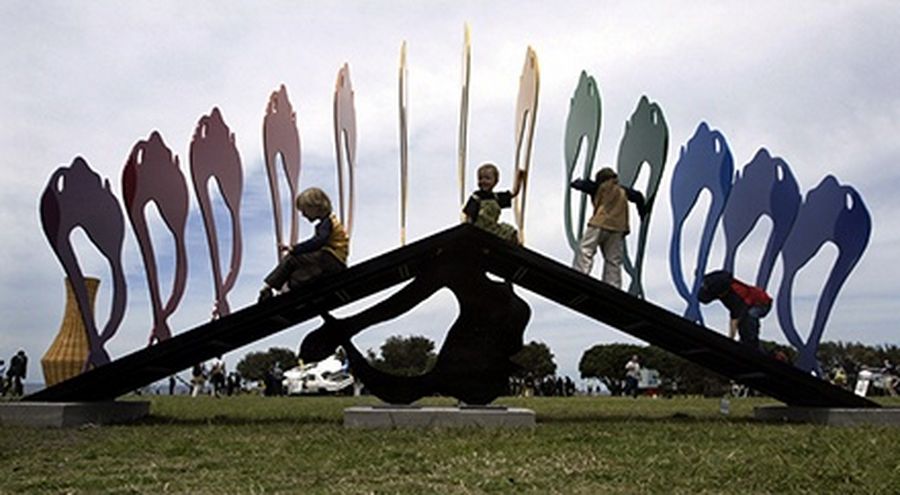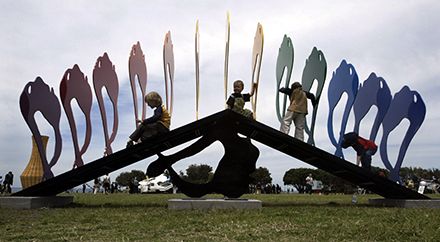Corporate bonds are rare in Australia’s bank-dominated local debt market, but G8 broke new ground with a landmark high-yield offering, before turning to Singapore to target Asian investors for cost-effective funding.

Eager to learn
Source: REUTERS/Adrees Latif
Liam Tucker, Rhys Tucker, Rory Eagle and Harry Longworth (L-R) conquer a sculpture at the ‘Sculpture By the Sea’ exhibit in Bondi Beach, Australia.
Australia’s under-developed high-yield bond market keeps expanding at a steady pace with almost A$1.3bn (US$1.16bn) raised at home during the last two years as more new entrants print debut deals.
However, while other high-yield issuers have sold just one local bond each, Australasian childcare centre operator G8 Education has launched more, innovative transactions this year.
The unrated ASX-listed company made its debut in the domestic high-yield market in August 2013 with a A$70m 7.65% six-year bond that was the biggest domestic high-yield bond targeted at private investors until 360 Capital’s A$75m issue 13 months later.
G8 returned in March this year with Australia’s inaugural floating-rate note from a non-investment-grade issuer. The A$50m four-year piece priced to yield 390bp over 90-day bank bills.
As with most high-yield deals, FIIG Securities, Australia’s largest specialist fixed-income broker, arranged G8’s two local transactions. Both had minimum investment sizes of A$50,000 rather than the typical A$500,000 required in the institutional market.
Such deals target high-net-worth individuals and self-managed superannuation funds, although some small asset managers have also participated in these offerings.
Australia has the world’s fourth-largest pension pool, with total assets of almost US$1.6trn, or 105% of the country’s GDP, according to the 2014 Towers Watson global pension assets study. Nearly a third of this pool comprises self-managed superannuation funds.
However, only 13% of Australia’s pension pool was allocated to bonds last year. That is less than half the global average of 29%, which leaves plenty of scope for a reallocation away from the dominant equity sector.
Mark Paton, managing director and CEO at FIIG Securities, said G8’s two domestic bond issues attracted over 1,000 primarily buy and hold investors, underlining the strong appetite for the sector and the issuer.
Two months after its local FRN, G8 Education made its first visit to the Singapore dollar bond market with a three-year bond issued off a S$500m multi-currency MTN programme.
The S$175m (US$139m) offering priced at par to yield 375.4bp over the Singapore dollar swap offered rate, or 4.75%. DBS was sole lead.
The offering was increased from an initial target of S$100m as the Australian issuer appeared to choose size over price, having hoped to pay a yield closer to 4.5%.
Nevertheless, G8 can be pleased with drawing a book of S$650m from 47 investors and pricing inside its outstanding Australian dollar bonds.
At the time, G8’s 2018 Australian dollar bonds would have swapped into Singapore dollars at high 4% to 5% range, meaning the deal did not include any new-issue concession.
Although private banks bought 75% of the deal, a respectable 25% went to fund managers, banks and others. Singapore investors bought 84%, while Hong Kong and others bought 16%.
On August 14, G8 Education tapped the bond for S$85m to lift the total amount of outstanding 2017 bonds to S$260m. DBS, which also arranged the reopening, attributed the increase to reverse enquiry.
“G8 initially tapped the domestic Australian market with two unrated issues, one fixed and one floating, establishing their credentials as a sound issuer. They were then able to leverage off this by establishing a Singapore dollar programme to align some of their funding needs for their Singapore assets,” Paton said.
“As a listed company, G8 now has four diverse sources of funding, from equity and bank debt to the domestic and international bond markets.”
Since the first FIIG-led high yield bond in September 2012, eight domestic companies have raised a combined A$475m, with only G8 being a repeat issuer.
New Zealand’s CBL Corp became the first Kangaroo corporate high-yield issuer in April with a FIIG-arranged A$55m 8.25% five-year senior secured note.
Australia’s four major lenders, which dominate syndication duties in Australia’s investment-grade market, have taken note of the growing relevance of Australia’s high-yield market.
National Australia Bank brought Australia’s high-yield bond market into the mainstream in June with the first deal arranged by one of the country’s major lenders.
Unrated data-centre provider NEXTDC raised A$60m from its debut offering, a five-year non-call 2.5 note, paying an 8.0% coupon and an additional, cumulative 1.0% upon redemption.
Meanwhile, Qantas Airways has taken advantage of the growing appetite for high-yield paper in Australia to sell the first such bond in the country’s institutional market in May.
The downgraded national carrier (Ba2/BBB+) sold an eight-year bond of A$300m before returning with a A$400m seven-year print following a month later.
Australia’s overall domestic high-yield issuance has now reached A$1.29bn, but this still represents a very small share of Australia’s overall bond market of close to A$1trn.
The country’s local private investor-focused high-yield market has a huge way to go to replicate the extraordinary depth of the US 144A and private placements markets, or the revived European markets, but progress is being made.
Further debutants are set to enter the fray with Paton expecting FIIG to bring another half a dozen or so new, unrated firms to the market over the next few months.
To see the digital version of this report, please click here.
